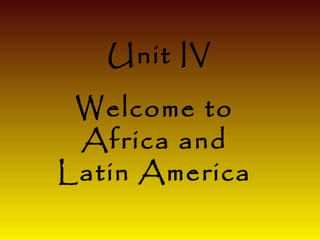
African & latin american music duskyrose
- 1. Unit IV Welcome to Africa and Latin America
- 2. Lesson 13 : Vocal Music from Africa Africa- home to approximately 80 million people from different cultural backgrounds and tradition. -this content is the birthplace of one of the world’s most unique musical styles. Music- an integral part of the lives of the African people. It is closely related to any aspects of their lives. It goes much deeper than just singing songs for rituals
- 3. Traditional African Music -it is used for worship and courtship, for easing hard work, and simply for giving pleasure or entertainment. The Griots- a highly skilled musicians - pass on tribal history through oral traditions. African music developed through the blending influences of the following: - European - African-American - Middle Eastern
- 4. Soukous- the congolese guitar band music - one of the most influential styles of popular music in Africa. -Characteristics of African Music- Characteristics of predominate African music: - Rhythmic patterns / movements - Percussive sounds Polyrhythmic- means they perform two or more basic rhythms simultaneously. Vocal style- another important element of African music.
- 5. Call-response Technique- in this technique, the lead singer who is highly trained, sings a line or a phrase which the rest of the group sings or echoes back. Most commonly observed musical practices in Vocal Music: -Glissandos - Bends - Swoops
- 6. Lesson 14: African Musical Instrument African Vocal Music- polyrhythmic and responsorial style. - its music is predominantly rhythmic and percussive. Handclapping- the basic rhythmic accompaniment of nomadic tribes. African Rituals and Ceremonies- on the musical accompaniment of drums, which id believed to help summon spirits.
- 7. Music- used as a means to communicate everyday tasks, religious events and calls to war. Some prominently known instruments: -Talking drums- of West and Central African tribes. -Talking xylophones- of the Jabo tribe. -Talking flutes- of the Nigerian tribe. Important as the playing of musical instruments: -Dancing, singing, clapping
- 8. Idiophones Most commonly used in Africa. These are commonly played by societies that did not used drums. 1.Rattles- made of dried gourd from the calabash tree and are covered with beads to create rattling sounds when tapped or shaken. Two kinds of Rattles: Primary Rattles- held by the hands.
- 9. Secondary Rattles- are worn by the performers on their bodies and activated through bodily movements. 2.Clappers- reproduce the sound of hand clapping for ceremonial purposes.
- 10. Scrapped and Stamped Idiophones- some sounds are produced by rubbing a gourd against a board by scrapping a bottle with a thin. Mbira (Sansa or hand piano)- this melodic idiophone is made from graduated series of wooden or metal strips that are arranged.
- 11. Xylophone- Made up of a series of wooden slabs or keys mounted on a clay post or on a wooden frame. Membranophones -Used to emphasize the rhythmic and percussive nature of their music. Drums- carved out of wood or made of strips of wood that are bound together.
- 12. -Come in various size and shapes. The most common instrument throughout Africa. Flutes- usually made from bamboo, stalks of millet, the tip of gourd, and the husk of cane.
- 13. Reed pipes- it is played by inhaling and exhaling through the slit around its opening. Trumphets and Horns- made from animal horns, elephant tusks and wood. Used for conveying signals and messages as well as music.
- 14. Chordophones Musical bows- the simplest of all African chordophones. Zither- are stringed instruments that are positioned horizontally.
- 15. Lutes- instruments with strings that run parallel to their necks and are played through plucking or bowing.
- 16. Lesson 15: Latin American Music Latin America- refers to the countries found on the South America Continent, as well as the entire Caribbean. -Latin American Musical Styles- Calypso- a form of music and dance popular in the Caribbean. It originated from the pre- Lenten carnival in Trinidad where musicians played their music nightly.
- 17. Rumba- an Afro-Cuban song and dance music that is polyrhythmic and is natural and spontaneous in its movements. It exhibits to fast tempos. Three part form: 1. improvised verses 2. repetitive call 3. response singing Merengue- well known vocal and dance music that was adopted from the Dominican Republic.
- 18. Tango- emerged at the end of 19th century from Buenos Aires. This dance was probably derived from the Milonga, a lively suggestive dance Argentina. Salsa- a musical style that was developed in New York City by the Urban Caribbean Hispanics.
- 19. Lesson 16: Musical Instruments of Latin America Latin American Music- one of the most influential kinds of music in the world. Different Musical Styles: 1. Tango 4. Rumba 2. Cha- cha 5. Salsa 3. Samba 6. Merengue
- 20. -Percussion Instrument- Maracas- a pair of dried gourds with wooden handles. They are played by shaking. Claves- pairs of round, hardwood sticks that are tapped together. They are used to play a special on going syncopated rhythm.
- 21. Bongo Drum- pair of drums struck by the hands. Congo Drum- single extra tall bongo, struck with the players hand. Cabasa- looks like a wooden spool with metal
- 22. beads wound around it and a wooden handle. Steel Drums- tuned metal barrels.
- 23. -String Instruments- Puerto Rican Cuatro- small four-stringed instruments similar to the largest ukulele. Tiple- it has four double/triple sets of strings that are used to accompany a certain music.
- 24. Charango- lute-shaped instrument with five pairs of string. -Wind Instrument- Panpipes- known as antaras, a type of wooden instrument from the Andes Mountain, now Peru.
- 25. Trumpets- wind instruments that are made from conch shells, tree barks and bamboo.
- 26. The end……..
